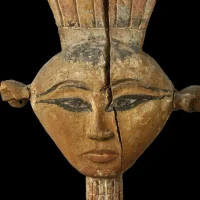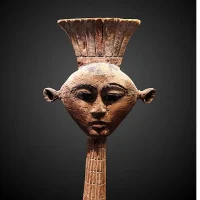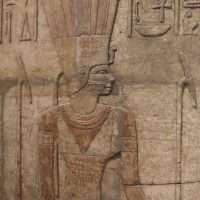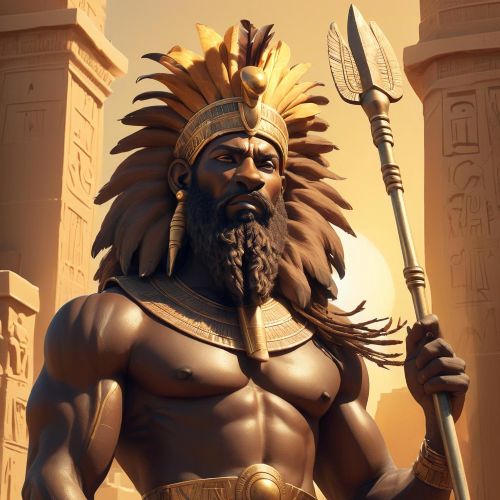Anuket : Goddess of the Nile Cataracts
Listen
At a glance
| Description | |
|---|---|
| Origin | North African Mythology |
| Classification | Gods |
| Family Members | Khnum (Father) |
| Region | Egypt, Sudan |
| Associated With | Nile, Fertility |
Anuket
Introduction
Anuket, also known as Anqet or Anukis, is an ancient Egyptian goddess revered as the personification of the Nile River’s life-giving power. Her worship was centered in the region of the First Cataract, near modern-day Aswan and Elephantine Island, where the Nile’s waters surged through narrow rocky passages before flowing north. Deeply associated with both Egypt and Nubia, Anuket represented nourishment, fertility, and protection, serving as the divine embodiment of the river that sustained civilization. Her name means “She Who Embraces,” symbolizing the river’s waters enveloping the land during the annual flood. As a central figure in the Elephantine Triad alongside Khnum and Satet, Anuket’s role reflected the Egyptians’ profound reverence for the Nile as a source of abundance, renewal, and divine grace.
Physical Traits
Anuket is most often depicted as a beautiful woman wearing a tall headdress crafted from reeds or ostrich feathers, symbols of fertility, grace, and connection to the river. This unique crown is also considered a nod to her Nubian heritage. She commonly carries an ankh, representing life, and a scepter that signifies authority and divine protection. In many depictions, she appears with a gazelle, her sacred animal, representing speed and elegance, or she may take the form of a gazelle herself. Artistic portrayals often emphasize her fluid, regal appearance, reflecting the dynamic movement of the Nile’s waters. In temple reliefs, she is shown suckling the Pharaoh, symbolizing her role as the divine mother and protector of kingship. Later iconography associates her with cowrie shells, symbols of fertility and sensuality, highlighting her dual connection to nurturing and desire. Her physical depiction thus embodies both the river’s vitality and the goddess’s feminine strength.
Family
Anuket’s divine lineage evolved across Egypt’s long history. In earlier traditions, she was known as the daughter of the sun god Ra, embodying his radiant and life-giving aspect. By the Middle Kingdom, she became part of the Elephantine Triad with Khnum, the ram-headed creator god of the Nile’s source, and Satet, the goddess of purification and fertility. In this grouping, Anuket was often regarded as either the daughter or consort of Khnum and the sister or daughter of Satet. Together, they governed the flow, purity, and abundance of the Nile, ensuring the prosperity of the land and people. Some later sources also identify Anuket as the daughter of Sobek, the crocodile god linked to fertility and the waters. Through these familial connections, Anuket’s mythology reflects the cyclical nature of creation, nourishment, and renewal themes central to Egypt’s understanding of divine order and the Nile’s significance.
Other names
Anuket was known by several variations of her name across time and culture, including Anket, Anqet, Anjet, and in Greek texts, Anucis or Anoukis. Her name, derived from the Egyptian root meaning “to embrace” or “to clasp,” refers to the Nile’s encompassing floodwaters that revived the land each year. To the Greeks and later the Romans, Anuket’s nurturing and protective qualities were reminiscent of Vesta, the goddess of the hearth, underscoring her association with life, warmth, and sustenance. She bore several epithets that reflected her divine influence: “Lady of the Cataracts,” acknowledging her dominion over the turbulent southern Nile; “Lady of Elephantine,” marking her cult center; and “Nourisher of the Fields,” celebrating her essential role in agricultural fertility. Other titles like “Mistress of Nubia” and “Lady of Life” highlight her importance both as a regional deity and as a universal symbol of vitality and protection.
Powers and Abilities
Anuket’s powers were intimately connected with the Nile’s ebb and flow. She was believed to govern the river’s annual inundation, which deposited nutrient-rich silt essential for farming, earning her the title “Giver of Life.” Her blessings ensured bountiful harvests, while her anger could bring drought or poor floods, underscoring her control over Egypt’s fate. During the “Festival of Anuket,” celebrated when the floodwaters began to rise, people cast offerings of jewelry, coins, and food into the Nile, thanking the goddess for her generosity. Anuket also served as a protector of travelers and fishermen who braved the Nile’s dangerous cataracts, shielding them from crocodiles and treacherous currents. In spiritual terms, she symbolized purification and renewal, her waters believed to cleanse and rejuvenate both body and soul. In later periods, Anuket’s domain expanded to include lust and sensuality, reflecting her name’s more intimate meaning of “embrace.” This association connected her not only to the fertility of the earth but also to human passion and procreation. As one of the “Eyes of Ra,” Anuket shared in the fiery power of other goddesses like Hathor, Sekhmet, and Bastet, capable of acting as both protector and punisher in defense of cosmic order.
Modern Day Influence
Though Anuket’s temples now stand in ruins, her legacy endures through modern scholarship, art, and cultural revival. She remains a symbol of the life-giving bond between humans and nature, embodying the importance of water as a source of fertility, survival, and balance. In Egyptology, Anuket continues to draw attention for her unique position as a bridge between Egyptian and Nubian spirituality, representing the shared reverence for the Nile across cultures. Her imagery marked by reeds, ostrich feathers, and the gazelle appears in modern artworks, digital illustrations, and mythology-inspired media, where she is often reimagined as a goddess of ecology and renewal. The annual flooding of the Nile, once celebrated in her honor, has inspired modern environmental analogies about respecting natural cycles and conserving water resources.
In popular culture and contemporary spirituality, Anuket symbolizes feminine power, abundance, and connection to the earth. She is sometimes invoked in neo-pagan or spiritual circles as a water goddess, embodying healing, fertility, and emotional renewal. Artists and writers draw on her myth to explore themes of flow, transformation, and the delicate balance between nurturing and destructive forces. Her Nubian heritage has also gained renewed recognition, highlighting her role in celebrating African mythologies beyond Egypt’s better-known deities. Through her enduring image as the “Embracer,” Anuket continues to remind humanity of the essential relationship between life and water, the eternal embrace that sustains all creation.
Related Images
Source
ancientegyptonline.co.uk. (2019, April 30). Anuket. Retrieved October 2025, from https://ancientegyptonline.co.uk/anuket/
Britannica, T. E. (2017, September 27). Anuket. Encyclopedia Britannica. Retrieved October 2025, from https://www.britannica.com/topic/Anuket
storiespub.com. (2023, May 14). The Majesty Of Anuket – The Goddess of the Nile River. Retrieved October 2025, from https://storiespub.com/anuket-goddess-of-the-nile-river/
redd.it. (2021, December 28). The Goddess Anuket. Reddit. Retrieved October 2025, from https://www.reddit.com/r/Cowofgold_Essays/comments/rqbgtt/the_goddess_anuket/
historycooperative.org. Anuket: The Ancient Egyptian Goddess of the Nile. Retrieved October 2025, from https://historycooperative.org/anuket/
cairotoptours.com. (2023, January 21). Anuket goddess powers. Retrieved October 2025, from https://www.cairotoptours.com/Egypt-Travel-Guide/Gods-of-Ancient-Egypt/anuket-goddess-
worldmythos.com. (2024, December 18). Anuket. Retrieved October 2025, from https://worldmythos.com/anuket/
wildwandering.com. (2024, May 20). Goddess Anuket – Wild Wandering. Retrieved October 2025, from https://thewildwandering.com/dailypracticeanuket
Wilkinson, R. H. (2003). The Complete Gods and Goddesses of Ancient Egypt. Thames & Hudson.
Pinch, G. (2002). Handbook of Egyptian Mythology. ABC-CLIO.
Bard, K. A. (2008). An Introduction to the Archaeology of Ancient Egypt. Wiley-Blackwell.
Lesko, B. S. (1999). The Great Goddesses of Egypt. University of Oklahoma Press.
Watterson, B. (1996). Gods of Ancient Egypt. Sutton Publishing.
Frequently Asked Questions
What is lorem Ipsum?
I am text block. Click edit button to change this text. Lorem ipsum dolor sit amet, consectetur adipiscing elit. Ut elit tellus, luctus nec ullamcorper mattis, pulvinar dapibus leo.
What is lorem Ipsum?
I am text block. Click edit button to change this text. Lorem ipsum dolor sit amet, consectetur adipiscing elit. Ut elit tellus, luctus nec ullamcorper mattis, pulvinar dapibus leo.
What is lorem Ipsum?
I am text block. Click edit button to change this text. Lorem ipsum dolor sit amet, consectetur adipiscing elit. Ut elit tellus, luctus nec ullamcorper mattis, pulvinar dapibus leo.
What is lorem Ipsum?
I am text block. Click edit button to change this text. Lorem ipsum dolor sit amet, consectetur adipiscing elit. Ut elit tellus, luctus nec ullamcorper mattis, pulvinar dapibus leo.
What is lorem Ipsum?
I am text block. Click edit button to change this text. Lorem ipsum dolor sit amet, consectetur adipiscing elit. Ut elit tellus, luctus nec ullamcorper mattis, pulvinar dapibus leo.












